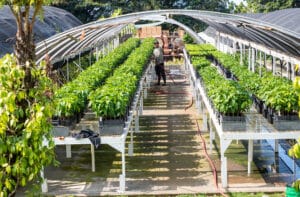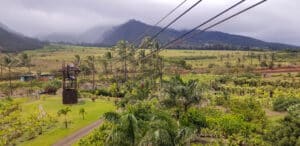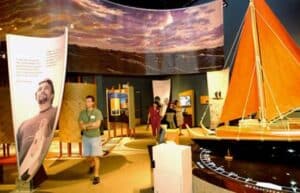
Ohi’a lehua flower with snow on Mauna Kea in background. (Photo Credit: Hawai’i Visitors Bureau)
Welcome to the Big Island!
At over 4,000 square miles, it’s easy to see how the Big Island got its nickname. And the best way to explore? Circumnavigating it by car. The Big Island of Hawaii is unlike any other place on Earth. Snow-capped mountains meet black sand beaches. Rainforests transition into lava deserts. Ancient Hawaiian culture pulses beneath the surface of every landscape.
If you’re short on time, a three-day Big Island road trip starting in Kona is the perfect way to explore the island’s incredible diversity. Born and raised here, I’ve driven every stretch and love sharing what makes this place so special. You won’t find bright lights, big crowds, or traffic jams — just wide-open roads, natural beauty, and space to breathe. Even a quick trip will help you slow down and reconnect. But fair warning: after three days, you’ll probably wish you had more.
There are parts of the island that this itinerary won’t cover. The Big Island is just too big. The Puna and Kohala districts aren’t included, but it’ll give you at least two great reasons to return.
What Makes the Big Island Special
The Big Island of Hawaii is known as the land of fire and ice. Fresh lava gushes from the Kilauea volcano when it erupts. Snow crowns Mauna Kea during the cooler months of December to February. On the Big Island, we have eight of the 13 defined climate zones, and beaches with white, black, and green sand.
For history lovers, it’s where British explorer Captain Cook landed in 1778 revealing the Hawaiian Islands to the world. Soon after, Native Hawaiians killed him. The Captain Cook monument is a landmark at Kealakekua Bay in Kona. It’s the home of King Kamehameha I, who was born and died on the island.

This statue of Kamehameha stands in Hilo. (Photo Credit: HawaiianScribe)
The Big Island is jam-packed and full of things to do — ocean sports, hiking, rainforests, historical sites, cultural events, or quiet browsing in antique stores and art galleries. Whatever you decide, you won’t be far from interesting eateries and food stops along the way.
Start in Kona
There is an airport in Kona and Hilo. I recommend flying into Ellison Onizuka Kona International Airport at Keāhole as more airlines service the town, which means better odds of landing earlier in the day to settle in and get started.
With this itinerary, you’ll spend one night in Volcano, a night in Hilo, and a choose-your-own-adventure on the final night in Waimea or back in Kona before flying out.
Day 1: Kona to Volcano via South Kona and the Southern Coast
Head south through the Kaʻū District to Volcano. You’ll be driving about 100 miles to Hawai‘i Volcanoes National Park. You won’t enter the park today, but I would suggest staying in the Volcano area overnight.
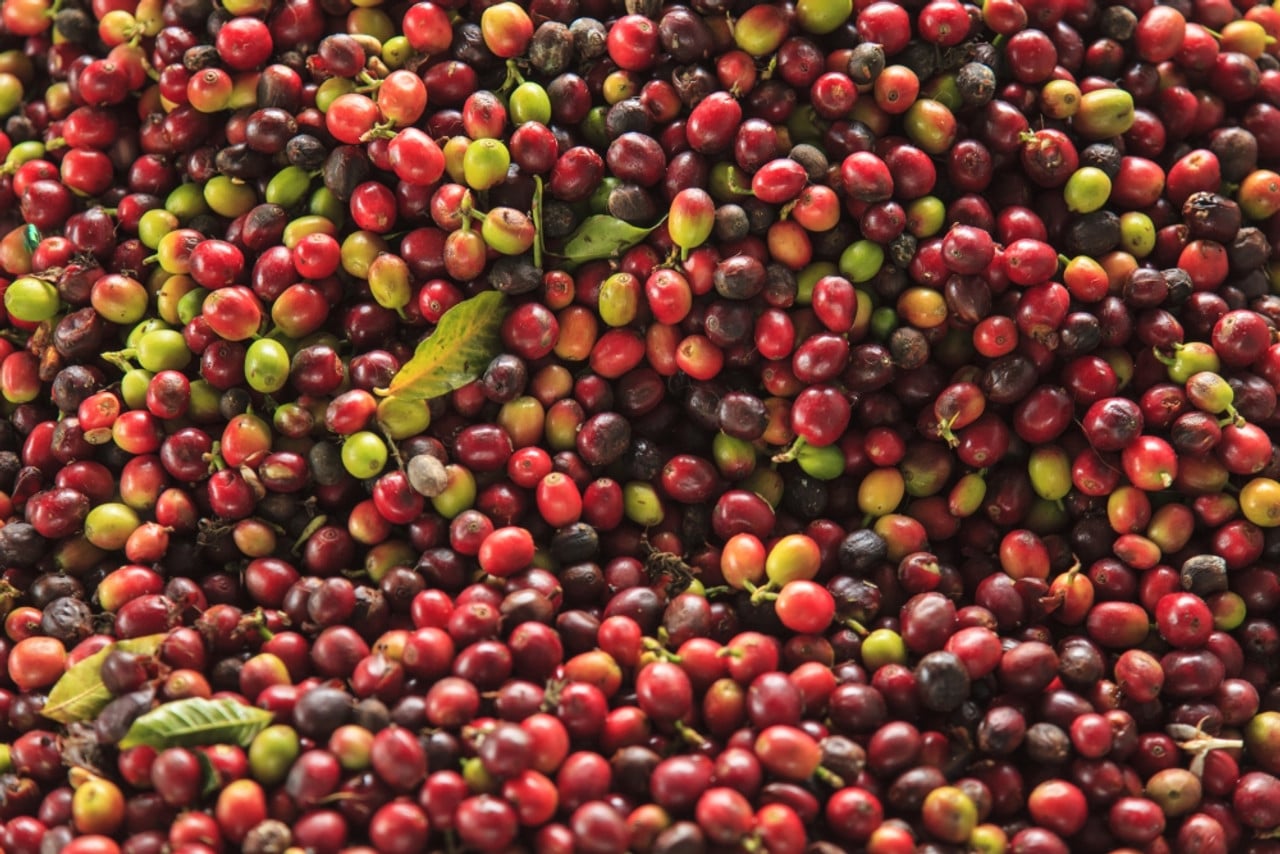
Fresh Kona coffee beans. (Photo Credit: HawaiianScribe)
Morning: Kona Coffee Country & Puʻuhonua o Hōnaunau
Start your day in Kona with a hot cup of island-grown coffee. Kona is famous for its rich, volcanic-soil-grown beans, so grab breakfast and a brew and head to Greenwell Farms. This well-known coffee farm offers hour-long tours and free java beginning at 9 a.m. daily with no reservations required. You’ll find out how the beans get from shrub to cup — well worth your time, especially for coffee lovers.
Puʻuhonua o Hōnaunau National Historical Park: Located about 22 miles south of Kailua-Kona, the National Park Service operates this 180-acre park. It was once home to ancient Hawaiian royalty before the arrival of Westerners. It also is a place of refuge for lawbreakers who were sentenced to death if they did not reach the sanctuary before being caught. Walk among carved wooden ki‘i (statues), stone platforms, and reconstructed hale (thatched huts) to the sound of waves crashing on the lava rock shores. You could easily spend a couple of hours on a self-guided tour and observing cultural demonstrations. It’s open daily from 8:30 a.m. to 4:30 p.m.
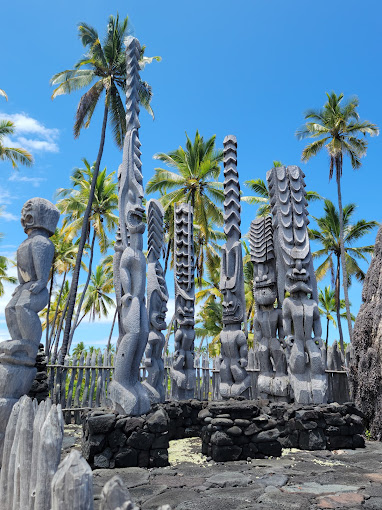
Hawaiian ki’i or statues of ancient gods. (Photo Credit: Puuhonua o Honaunau)
Midday: South Point (Optional Detour)
South Point: This is the halfway point between Kailua Kona and Volcano. South Point is the southernmost point of the United States, and some historians think this was the first landing spot for ancient navigators via canoe, which is well worth a stop just to say you’ve been there. While the drive itself is unremarkable, it’s about 12 miles off the main highway and provides a panoramic view of the Pacific Ocean. It’s desolate and windy, and you’ll pass a few farms, cattle, horses, and maybe a food truck or fruit stand if you’re lucky. Once back on the main road, you’ll be in the Kaʻū District.
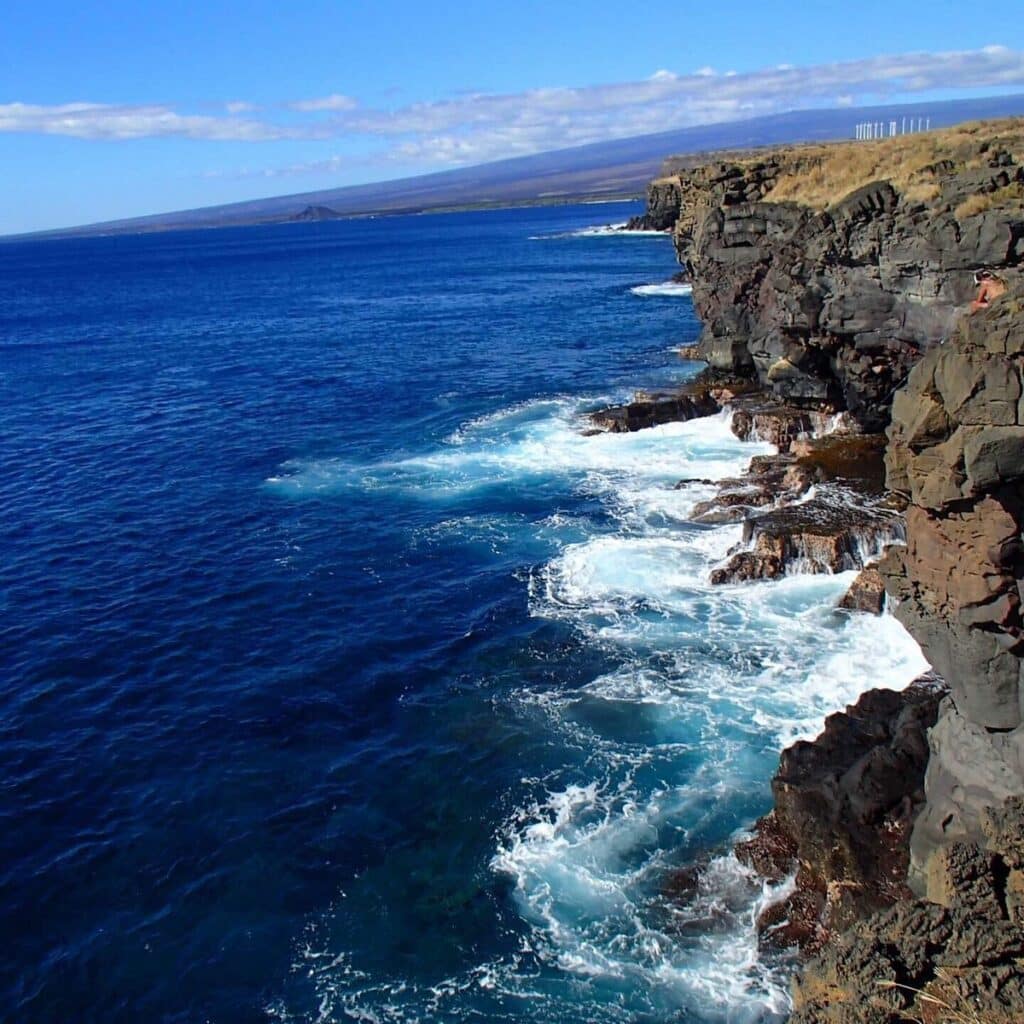
Sheer cliffs at South Point. (Photo Credit: HawaiianScribe)
Afternoon: Punalu‘u and Volcano Winery
Punalu‘u Bake Shop is a great place for a leisurely pit stop, lunch and to snag some souvenirs. The bakery is excellent – get some malasadas (Portuguese buns), their famous sweet bread, and local favorites like eclairs, turnovers, and cheesecake. Order a plate lunch and eat outside in the tropical garden. They’re open daily from 8:30 a.m. to 5 p.m.
Punalu‘u Black Sand Beach – A highlight of any Big Island visit, the black sand beach is also a sea turtle sanctuary so there are usually several turtles lazing on the sand. They’re protected, so keep your distance, but feel free to marvel at their presence — it’s one of the most iconic sights on the island. If it’s not too late in the day, check out the gift shop run by locals right on the beach. The black sand gets hot and windy, in case you were wondering why people aren’t laying out on the sand.
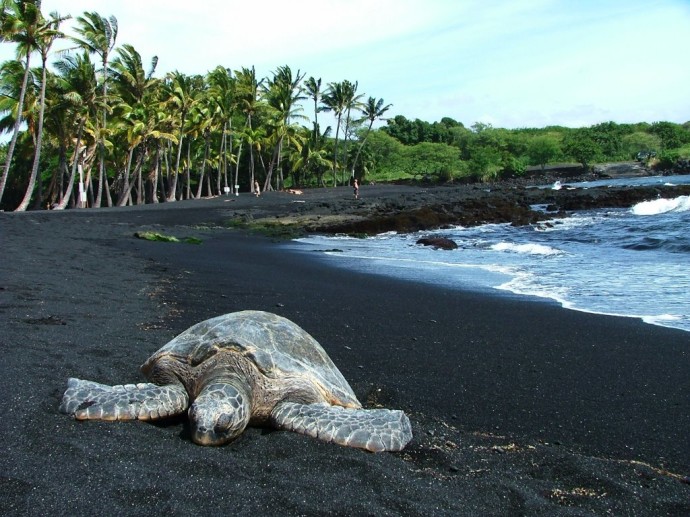
Sea turtles come up onto the black sand at Punalu’u. (Photo Credit: HawaiianScribe)
Volcano Winery – Established in 1986, the winery harnesses the unique volcanic soil to cultivate Symphony grapes, demonstrating that even in the most unexpected terrains, viticulture can thrive. For a midday pick-me-up, they offer daily tastings from 12 to 5:30 p.m. or guided tours at 12:15 p.m. (advance reservations required). There is also a one-hour tour of their tea fields with tastings of the white and black varietals.
Evening: Volcano Village and Hawai’i Volcanoes National Park
Although you probably didn’t notice, your Big Island road trip drive has taken you up quite the elevation gain — 4,000 feet above sea level. As sunset approaches, Volcano Village comes into view, a misty, fern-filled enclave on the edge of Hawaii Volcanoes National Park. Evenings are often cool and rainy, but if you’re lucky to be there on a clear night, look up. The stars are amazing.
If you still have energy, the park after dark is a sight to behold. Open 24/7, you won’t find rangers on duty, and need to be prepared with flashlights, emergency supplies, and layers of clothing. If there’s volcanic activity reported (check NPS conditions in advance), head to the Halemaʻumaʻu Crater overlook and obey all hazard signs. Seeing molten lava glowing against the night sky is an unforgettable experience.
Note: The entrance fee per vehicle is $30, and if you enter the park at night, you’ll have to pay again in the morning unless you have a National Parks Pass.
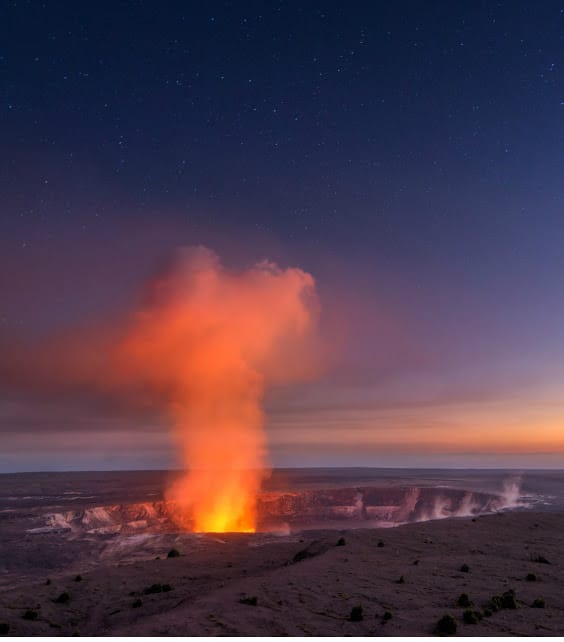
An evening with Pele. (Photo Credit: Michael Brandt)
Where to Stay Near Hawaii Volcanoes National Park
- Hawaii Volcanoes National Park has a campground for tent camping, as well as in-demand cabins that sleep one to four people.
- Hawaii Volcano House – A historic hotel with 33 guest rooms situated near the edge of Kilauea Crater. An onsite restaurant offers upscale dining.
- Volcano Village Lodge – A bed and breakfast two miles from the park that’s popular with travelers.
- Kilauea Lodge – A well-known vintage lodge with an onsite restaurant in Volcano Village right outside the park.
Where to Eat Near Hawaii Volcanoes National Park
There aren’t many choices in Volcano Village but your best bets are…
- Thai Thai Bistro & Bar – Delicious Thai food. Their special curry is outstanding. Quality of service can sometimes vary.
- Lava Rock Cafe – Their menu is a mix of American and Big Island-style food with plate lunches and dinners, sandwiches, burgers, pasta, wine, and beer.
Day 2: Volcano to Hilo
Morning: Explore Hawai’i Volcanoes National Park
Wake up early and make the most of your time in this UNESCO World Heritage Site. You can easily spend an entire day exploring the park with hikes like the Kilauea Iki, where you’ll walk across a once-molten lava lake. Drive the famed Chain of Craters Road all the way to the ocean, a 19-mile scenic route passing old lava flows and lookouts. If you’re into geology or just awestruck by Earth’s raw power, the park delivers with its active volcanoes.
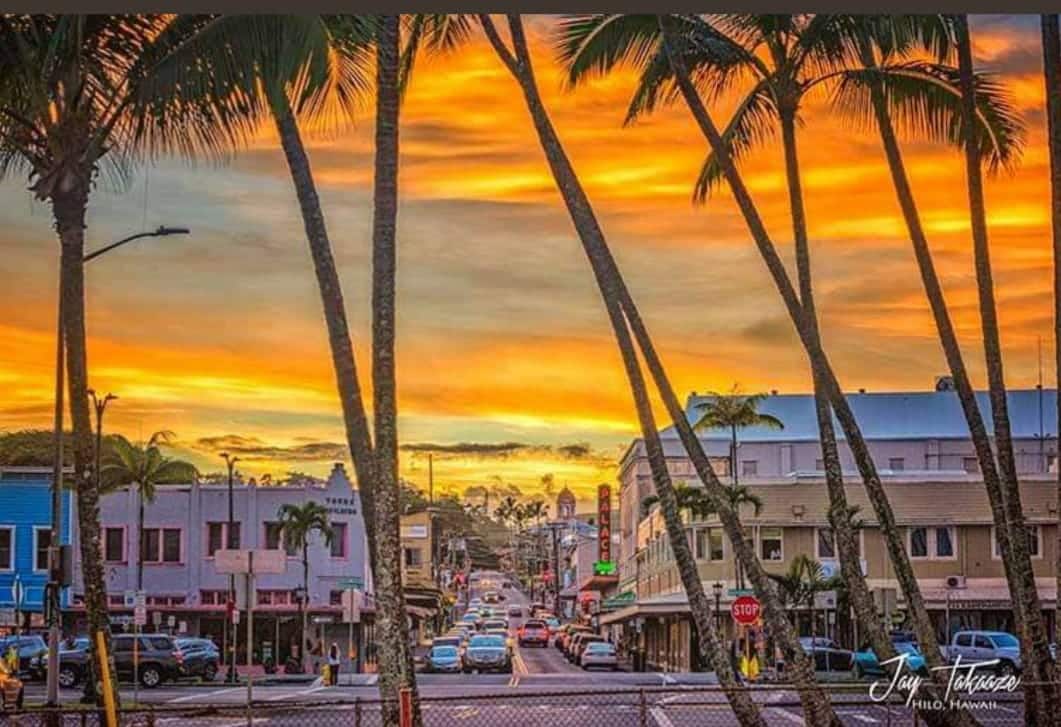
Sunset over historic downtown Hilo. (Photo Credit: Jay Takaaze)
Midday: Drive to Hilo
Drive the 30 miles from Volcano to Hilo. Hilo feels different than Kona — cooler, greener, and more laid-back.
Things to do in Hilo:
- Rainbow Falls – If there have been recent heavy rains, the falls will be thundering. Otherwise, it’s pretty mild and picturesque.
- Walk Around Historic Downtown Hilo – Charming storefronts, colorful murals, and a chill vibe transport you to old Hawaiʻi with a dash of hipster flair.
- Stroll Liliuokalani Gardens and walk over the bridge to Coconut Island – The 360-degree view of Hilo Bay is amazing.
Where to Stay in Hilo
- SCP Hilo Hotel: I highly recommend this family-run hotel with a retro feel. It’s great to unwind. Coconut Grill, their onsite restaurant, is convenient with a family-friendly menu.
- Dolphin Bay Hotel: Close to Downtown Hilo, it’s consistently rated the nicest small hotel in Hilo.
- Hilo Honu Inn Bed and Breakfast: Quaint and right up the hill from downtown Hilo.
Where to Eat
- Ponds Hilo: Overlooking Ice Pond, directly across from SCP Hilo Hotel. Ask to sit by the window.
- Seaside Restaurant & Aqua Farm: Fresh seafood is plucked straight out of the ponds surrounding the restaurant.
- Moon and Turtle: Located in downtown Hilo, it’s an innovative Asian-fusion restaurant with a menu that changes often to accommodate locally sourced foods.
Day 3: Hilo to Waimea along the Hamakua Coast
This itinerary includes dinner in Waimea, whether or not you choose to stay overnight. If you’re flying out the next morning, plan for about a 1-hour drive from Waimea to Kona International Airport.
Morning: Head back toward Kona
Paul’s Place: Located in downtown Hilo, this would be a great morning send-off. Paul’s is a tiny niche restaurant with just three tables. The Belgian waffles are spectacular. Reserve way in advance and arrive on time. They’re open daily from 7:30 a.m. to 2 p.m.
Hawai‘i Tropical Botanical Garden: For gorgeous views of the Onomea coastline, this tropical rainforest oasis has over 2,500 species of plants. They’re open daily from 9 a.m. to 5 p.m.
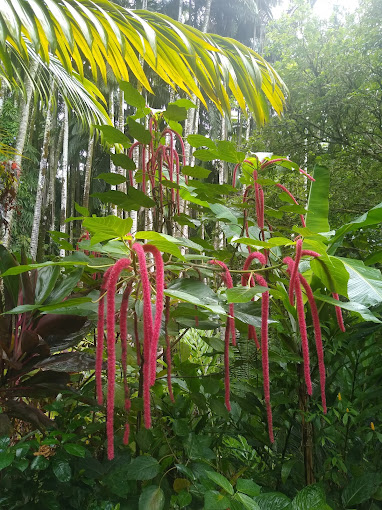
Local red chenille plant (Photo Credit: HawaiianScribe)
Triple Tier Umauma Falls: You can explore the waterfalls and tropical gardens for a nominal fee. The property also offers horseback riding, ziplining, ATV tours, e-bike rentals, and kayaking.
Afternoon: Keep Driving
You’ll pass the small plantation town of Honoka‘a in the early afternoon. There’s not much to see if your time is limited, but Tex Drive-In is on the main highway. They have plate lunches, a nice little rest stop, and are known for an assortment of malasadas (Portuguese buns) in unique flavors. They’re open from 6 a.m. until 6 p.m.
Half an hour past Tex, you’ll reach Waimea. It’s Paniolo (cowboy) Country with Parker Ranch taking up most of the pastureland and rolling hills. They offer self-guided tours of the two historic family homes to see the heirlooms and artwork. Reservations are required with tours available at 10 a.m., 11 a.m., and 1 p.m.

A good pitstop on the Big Island (Photo Credit: Merrimans Waimea)
Where to Eat in Waimea
For a backcountry town with rolling green hills, their food is surprisingly good.
- Fish and the Hog: A market cafe offering fresh island fish, BBQ, sandwiches, and salads. They’re family-friendly and do get crowded. Open daily from 11:30 a.m. until 8:30 p.m.
- Merriman’s: Upscale and pricey, Chef Peter Merriman is known for his excellent cuisine that uses fresh local ingredients. Reservations are required for dinners from 5 until 8:30 p.m.
- For a festive finale on the Big Island, try the Paniolo Sunset BBQ Dinner. The buffet dinner includes prime rib, BBQ chicken, sides, desserts, and non-alcoholic drinks with country music, line dancing, roping, and Hawaiian-style fun. Reservations are required. The show is on Wednesday nights from 5:30 p.m. to 8:30 p.m. at Kahua Ranch.
Where to Stay in Waimea
- Kamuela Inn: A boutique hotel with just 30 rooms and upcountry hospitality including complimentary continental breakfast.
Return to Kona
Whether you spend the night in Waimea or head back to Kona, you’ve already seen a good chunk of the Big Island’s diverse and vibrant soul — but there’s still so much more to discover. Chances are, you’re just beginning to fall in love with this island… and might already be dreaming about your next trip.
Big Island Road Trip Travel Tips
- Rental cars: A standard vehicle will be fine for most of the trip, but if you plan to go to the summit of Mauna Kea, you’ll need a 4WD. Be sure to test the windshield wipers before leaving the lot because tropical showers are part of Big Island life.
- Check the weather and road closures: Conditions can vary dramatically from location to location on the Big Island, so stay informed, especially if you’re heading into higher elevation or more remote areas.
- Respect the land and culture: Many of the sites you’re visiting are sacred. Tread lightly and be respectful.
- Pack layers: From the sunny Kona coast to chilly Volcano nights, you’ll experience a range of temperatures.
- Bring binoculars and an umbrella. You’ll have lots of opportunities to use them on your Big Island road trip.
- Pack hiking boots. The trails can get muddy and trekking over lava is rough on tennis shoes.
The Big Island is vast, raw, and endlessly fascinating. Even in just a couple of days, it leaves an impression that’s hard to shake. So hit the road, keep your eyes open, and let the Big Island work its magic.

Waipi’o Valley Lookout. (Photo Credit: HawaiianScribe)
If You Have Extra Time: Waipiʻo Valley Lookout or Mauna Kea
Waipiʻo Valley Lookout
Continue driving north on the Hāmākua Coast and turn into the little town of Honoka‘a. It’s a nine-mile drive from the main highway to the Waipiʻo Valley Lookout for one of the most jaw-dropping vistas on the island. The valley is sacred, dramatic, and lush. Access is currently restricted to valley residents, tour operators, and Native Hawaiians practicing traditional cultural rights.
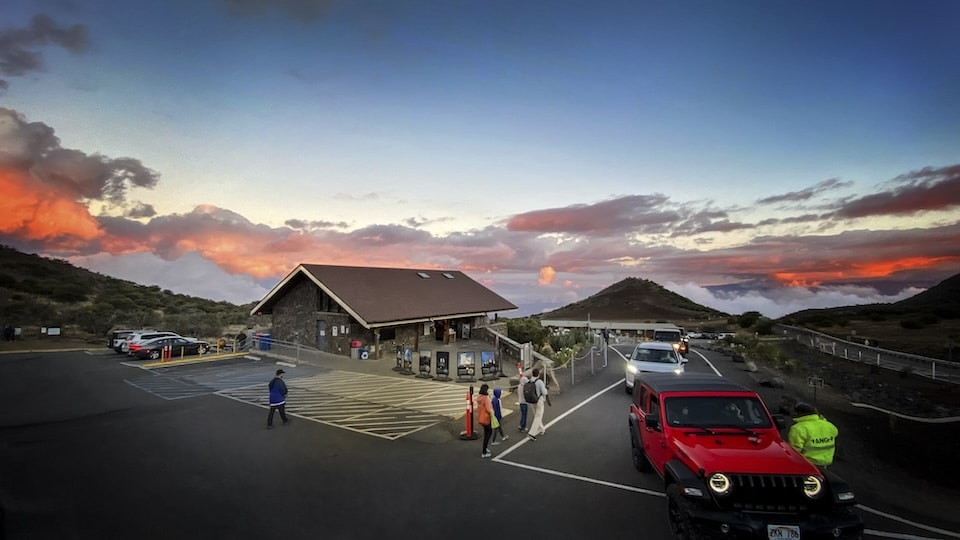
Mauna Kea Visitors Center at 9,200 ft. elevation. (Photo Credit: State of Hawai’i)
Summit of Mauna Kea
If the skies are clear and you’re craving a true high point — literally — drive up 9,200 feet to the Mauna Kea Visitor Information Station. The summit (13,803 feet) requires a 4WD vehicle, and conditions change fast, but even if you don’t go all the way up, stargazing from the visitor center is phenomenal.

